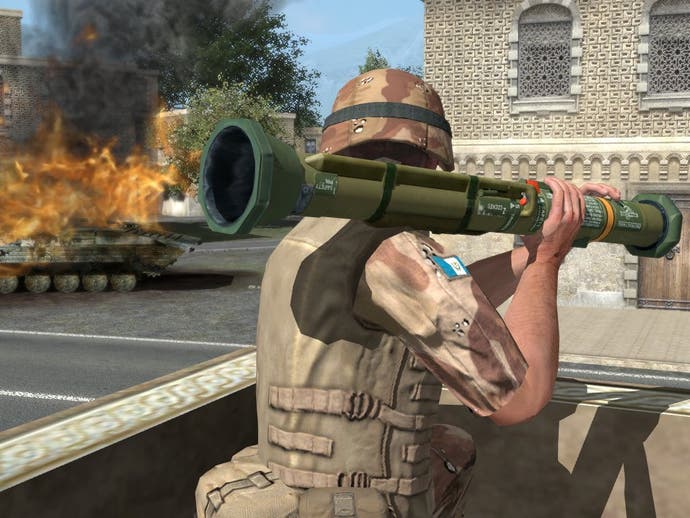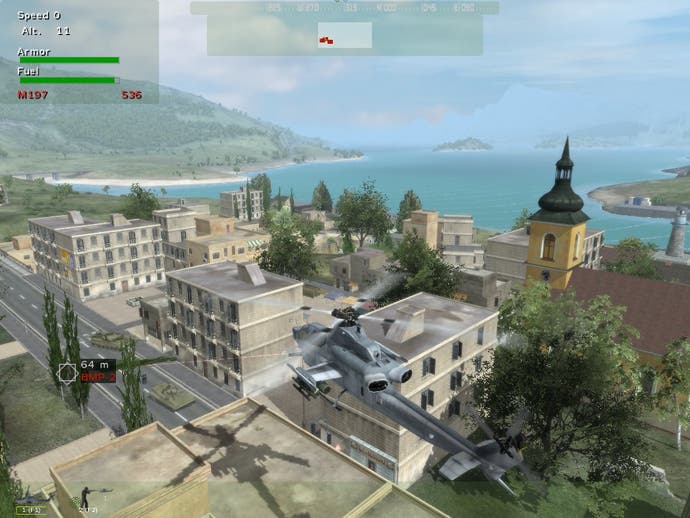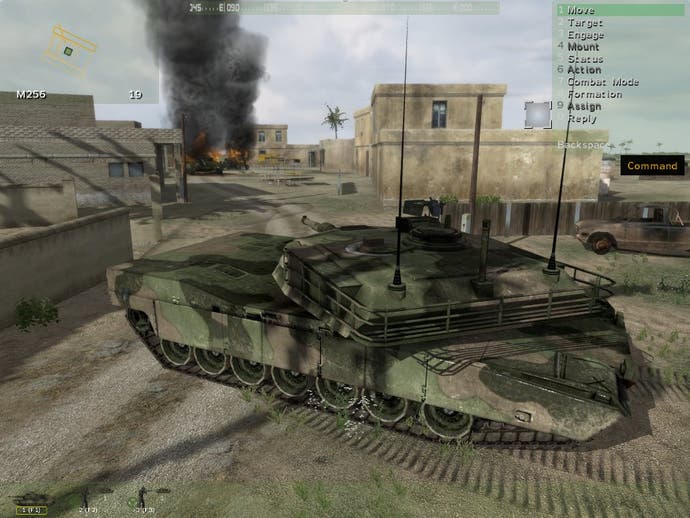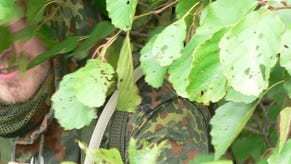Armed Assault
Bring your own bodybag.
7.30AM. A secluded clearing a few clicks inland of South Sahrani's coastal highway. A man heavily laden with weaponry moves from the zebra-stripe shadows of the spruce forest to a beat-up pick-up truck parked in the centre of the clearing. He gets in and drives away.
7.37AM. The truck sits abandoned in the middle of the highway. The driver is a hundred yards down the road crouched on the verge fiddling with a small canvas satchel. As the rumble and squeak of approaching traffic grows louder he finishes his work and jogs up a nearby hill towards a small stand of pines.
7.40AM. For the man under the pine trees the world is now ten yards of tarmac framed by the steel circle of an M136 AT weapon sight. Grass waves languidly in the lower half of the circle. For a few moments a turquoise dragonfly hovers in the centre. As the nimble insect departs the squat sluggish mass of a BMP-2 infantry fighting vehicle takes its place.
7.41AM. Hungry flames, swirling smoke, unseen death. The BMP-2 burns merrily on the melting blacktop. When the pair of lorries behind it lurch to a stop, the man sets-off the satchel charges. KA. BOOM.

7.45AM. Troops from the third lorry are working their way up the hill towards the pines. The man tracks one through the green-tinted scope of his M4 Aimpoint assault rifle and fells him with him two shots to the chest. A crouching machinegunner gets three rounds.
7.53AM. The crackle of small-arms fire has died away and the hum of the insects and the glitter of birdsong has returned. The man walks down the hill, surveying the grim carnage as he goes. He takes a Dragunov sniper rifle from the bloody hands of one corpse and examines it. He's still holding the weapon when the sound of an approaching reconnaissance jeep reaches his ears. 'Handy,' thinks the man.
8.12AM. With the aid of the requisitioned ride the man reaches the rendezvous point in good time. Before the Black Hawk arrives to carry him off to the land of soft mattresses, hot showers, and cold beers he has time to read four pages of All Quiet On The Western Front and pick a glossy yellow buttercup for his lapel.
Jackanory ends here

With the exception of the book reading and the flower picking (poetic licence) the above is a pretty accurate account of the wonderfully immersive mission I completed earlier today. If I had ten times as much room (and you had ten times as much patience) then I'd also provide accounts of my ten previous unsuccessful attempts at this mission. Chronicling every failure - the times the troops or the BMP-2 cut me down, or I blew myself up with my own satchel charges or rockets - would illustrate perfectly just how different ArmA is from most military shooters. Make no mistake: this game is harsh.
A lot of the harshness is down to something that's in rather short supply in the majority of military-themed titles - realism. One-shot-kills from quarter of a mile away, far-reaching splash damage, and wounds that leave you unable to do anything but slither on your belly like a snake, will come as a massive shock to anyone unfamiliar with ArmA's uncompromising ancestor Operation Flashpoint. Even if you know OFP intimately you may find yourself questioning the difficulty threshold in ArmA. One seemingly small enhancement - the lovely carpet of herbage that now covers rural terrain - has big tactical implications. Going prone in a field or wood is great for a bit of impromptu botany but is frequently suicidal in a firefight. Enemies seem to have little trouble spotting you through the stalks, but spotting them back can be nigh-on impossible. Bohemia Interactive is aware of the inequality and is adding a 'no grass' setting to the first patch. That's great, but you have to wonder whether the problem doesn't have more to do with AI than visuals.
Apart from the eagle-eyed spotting, CPU-controlled grunts don't seem to act all that differently to the way they acted in OFP. This means they're no pushovers, but they aren't exactly cunning either. They'll approach or attempt to flank you if they're in the mood, but often they just hit the dirt and return fire with fiendish accuracy. It's a shame BI couldn't have introduced some more subtle and varied behaviours. How nice it would be to see opponents lean from corners and doorways to unleash quick volleys. How nice it would be to see more signs of cowardice, fear, and co-ordination in their behaviours. Then again, given the current challenge level, perhaps it's a good thing the bad guys aren't more resourceful.
Our friends in the north

The bad guys in this instance are the Russian-backed troops of the undemocratic Democratic Republic of Sahrani (the northern half of a vast, seamlessly rendered fictional island). At the beginning of the campaign they storm across the border into the US-backed Kingdom of South Sahrani kickstarting a conflict that ensnares a hapless bunch of American soldiers just about to return to the States. You're one of those Americans and quickly find yourself going toe-to-TOW with a Red Square May Day parade's worth of Warsaw Pact hardware. Early missions are hopeless (in a good way) - scary retreats, cocky counter-attacks and daring covert interdictions. Later, support arrives and the South goes on the offensive.
Whether you're clobbering a convoy, sabotaging an ammo dump, or taking part in a tank battle, the scenarios swarm with tactical possibilities. As in OFP there's a powerful sense of war as something sprawling, sporadic and unpredictable. There are occasions - not many admittedly - when you seem to spend as much time getting to and from firefights as you do actually participating in them. Spending extended periods tabbing through the countryside or bouncing around in a Land Rover or Stryker APC might sound deathly dull, but can be quite immersive, especially if you're the one doing the driving. If the naturalism falters anywhere it's in the optional side missions. Before starting one of the main campaign episodes you get a chance to improve the odds by successfully completing a supplemental sortie. A fair few of these sideshows are fun but improbable lone-wolf affairs. However short the South Sahrani military are of personnel you'd think they'd be able to send out more than one man to take-on a base crawling with guards.
On a solo operation you obviously can't jump into the boots of another team-leader if your first character kicks the bucket (a welcome new feature) and more importantly you don't get the chance to play with ArmA's array of command options. In addition to the first-person and third-person cameras, there's also an overhead tactical camera available which allows the game to be played a bit like an RTS. I say 'a bit like' because ArmA still relies on OFP's rather convoluted menu system for dishing-out orders. With a Close Combat or Combat Mission-style interface, manoeuvring men and vehicles would be a breeze rather than a battle.
Slippery cobras

By far the simplest and most reliable way to get a vehicle to do what you want it to do is clamber aboard and grab the wheel yourself. Everything from buses to Black Hawks, Humvees to Harriers, motorbikes to motorboats, is crewable in this game. Apparently BI has improved the flight models since OFP. Frankly I didn't notice. Whatever it has done there's certainly room for further improvement. I can handle the choppers in Flight Simulator X with few problems, but getting the likes of ArmA's Cobra and Hokum lined up with targets is a real palaver. More flight model configuration options and a transparent cockpit toggle would have been most welcome. As avionics and weapons are already massively simplified, there's no good reason not to offer powerful aids.
Cripes, this is all starting to sound a bit negative. While it's true ArmA doesn't make great strides in areas like AI, command-and-control, and vehicle simulation (none of which were awful in OFP) there's one vital area where the progress is massive. Visually ArmA is a bit of a peach. There are times when you glance across at a crouching comrade, stare over the rolling fields towards a distant town, or peer through a gun sight at a wreckage-strewn street, the illusion is so convincing - so complete - you just have to pause and savour the magic. Given Sahrani's scale - 400 square kilometres - you'd expect large swathes of it to look pretty generic. The fact that you can set up a skirmish with the mission editor confident that any spot on the map will be atmospheric, believable, and tactically interesting is a testament to some great landscape gardening.

The campaign is no weekend wonder (I'm 14 missions in and it still feels like there's a way to go) and the single mission selection should keep you going for a long while (one of the 12 scenarios is a miniature campaign in itself) but ArmA's secret weapon is that very approachable mission creation tool. A couple of evenings ago I wanted to test vehicle damage models so set up a little scenario involving an OPFOR checkpoint and a Humvee. The thing took a couple of minutes to create and I ended up playing it for three hours straight totally forgetting my experiments. No other military shooter makes fashioning your own skirmishes anywhere near as easy.
Because OFP was so extensively and brilliantly modded and many of those same enthusiasts are already getting to grips with this unofficial sequel (it's been out for a while in central/eastern Europe) ArmA is bound to burgeon as time passes. Right now it's an essential purchase for anyone interested in war simulation or tired of the contrived drama that fills mainstream military shooters.


